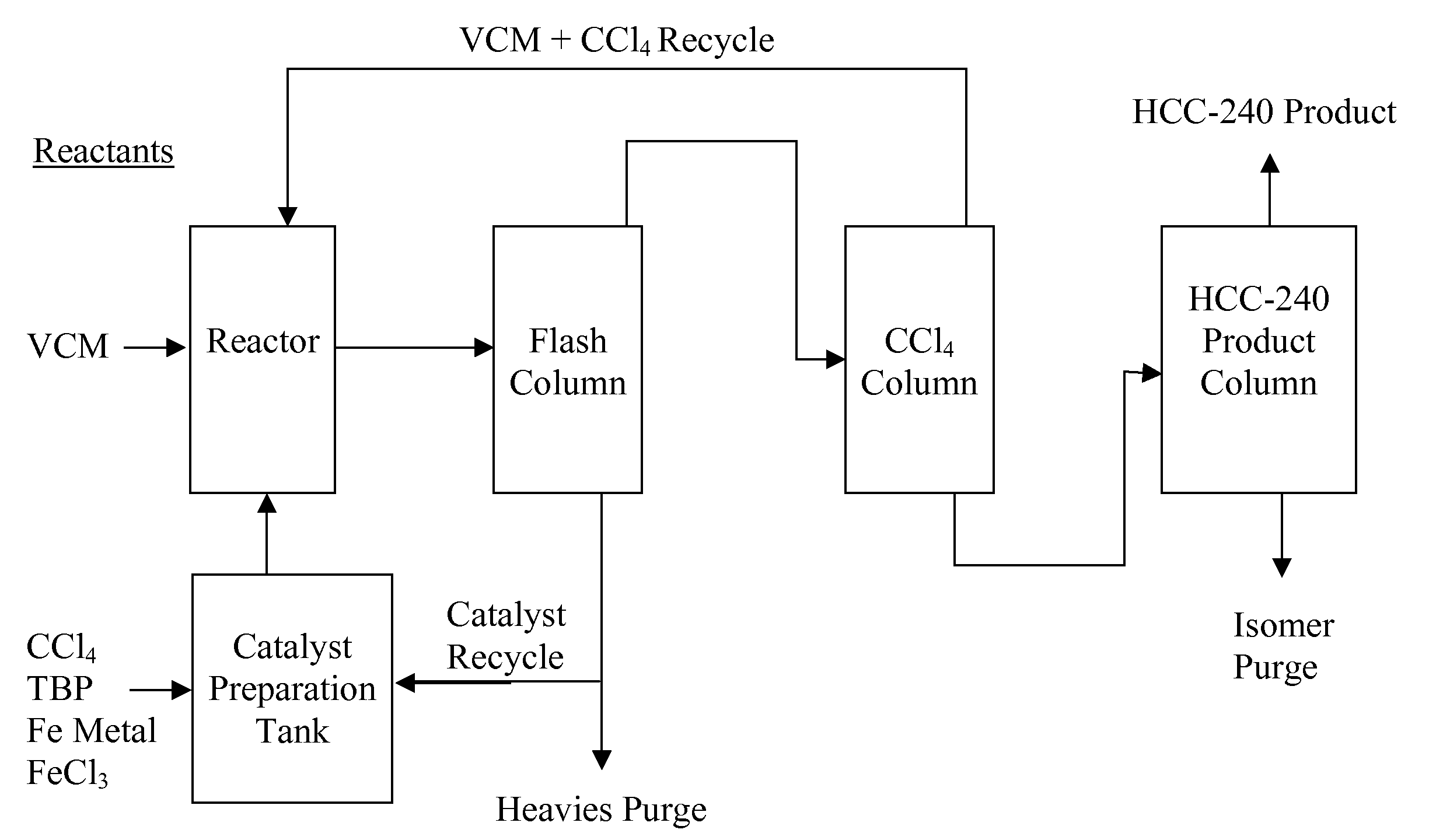Process for the manufacture of 1,1,1,3,3-pentachloropropane
a technology of pentachloropropane and process, which is applied in the direction of halogenated hydrocarbon preparation, halogenated hydrocarbon separation/purification, organic chemistry, etc., can solve the problems of inability to recycle catalysts, process is not readily adapted to continuous operation, and cannot be recycled
- Summary
- Abstract
- Description
- Claims
- Application Information
AI Technical Summary
Benefits of technology
Problems solved by technology
Method used
Image
Examples
example 1
[0040]In a Monel autoclave heated to 150°C., 1.8 g cuprous chloride (0.018 mol) and 230 g acetonitrile (5.6 moles) are mixed with 431 g carbon tetrachloride (2.8 moles) to form a mixture. The acetonitrile also serves as a solvent. Solid CuCl remains in the solution and is removed from the mixture by decantation. Thereafter, 98 g (1.57 moles) of vinyl chloride monomer are added to react with this mixture that contains carbon tetrachloride. The reaction time is 10 hours and the initial pressure is about 220 psig. HCC-240 is produced with 95 mol. % selectivity and VCM conversion is 95 mol. %. HCC-470 (CCl3CH2CHClCH2CHCl2) and HCC-240db (CCl3CHClCH2Cl) are formed as byproducts
example 2
[0041]In a Monel autoclave heated to 95° C., 2.5 g cuprous chloride (0.025 mol) and 5.2 g t-butylamine (0.07 mole) are mixed with 634 g (4.1 moles) of carbon tetrachloride to form a mixture. No solvent is used. Solid CuCl remains in the solution and is removed from the mixture by decantation. Thereafter, 119 g (1.9 moles) of vinyl chloride monomer is added to react with the carbon tetrachloride mixture. The reaction time is 10 hours and the initial pressure is about 220 psig. HCC-240 is produced with 93 mol. % selectivity and VCM conversion is 66 mol. %. HCC-470 (CCl3CH2CHClCH2CHCl2) and HCC-240db (CCl3CHClCH2Cl) are formed as byproducts.
example 3
[0042]In a catalyst preparation tank, as shown in FIG. 1, about 10 kg of iron powder and 1.3 kg of CCl4 are added. The tank is equipped with an agitator and is heated to 100°C. after adding the 10 kg of iron powder and 1.3 kg of CCl4. Subsequently, 9.2 kg / hr of CCl4, 0.24 kg / hr of tributylphosphate, and 0.29 kg / hr of ferric chloride are added and mixed in the tank. The mixed solution is passed through a filtration screen at the outlet of the tank and fed to a reactor that is controlled at 100°C. A separate feed line is used to feed 3.8 kg / hr vinyl chloride directly into the reactor. The pressure of the reactor is maintained at about 7 kg / cm2. The crude product leaving the reactor is fed to a flash-distillation column. The flash-distillation column is run under a slight vacuum. The overhead of the flash column is fed to a fractionation column (see CCl4 Column in FIG. 1) where un-reacted CCl4 and vinyl chloride are distilled and fed back to the reactor. The bottom of the flash column ...
PUM
| Property | Measurement | Unit |
|---|---|---|
| temperature | aaaaa | aaaaa |
| temperature | aaaaa | aaaaa |
| residence time | aaaaa | aaaaa |
Abstract
Description
Claims
Application Information
 Login to View More
Login to View More - R&D
- Intellectual Property
- Life Sciences
- Materials
- Tech Scout
- Unparalleled Data Quality
- Higher Quality Content
- 60% Fewer Hallucinations
Browse by: Latest US Patents, China's latest patents, Technical Efficacy Thesaurus, Application Domain, Technology Topic, Popular Technical Reports.
© 2025 PatSnap. All rights reserved.Legal|Privacy policy|Modern Slavery Act Transparency Statement|Sitemap|About US| Contact US: help@patsnap.com


